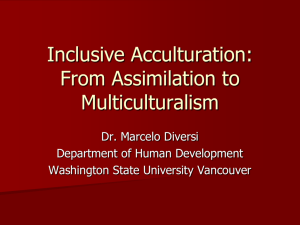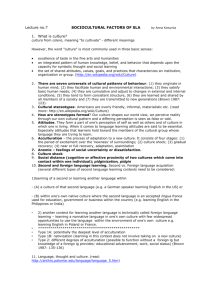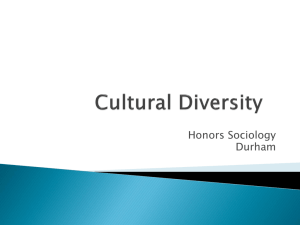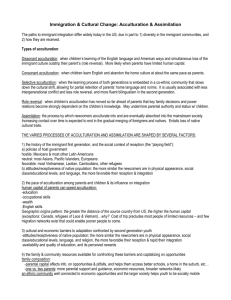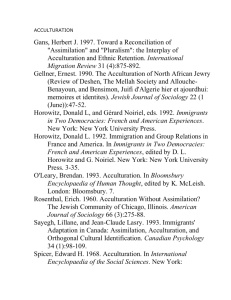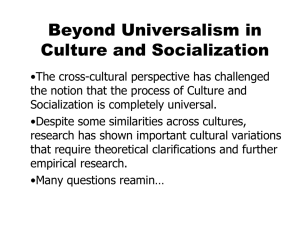Do multicultural experiences foster creativity?
advertisement
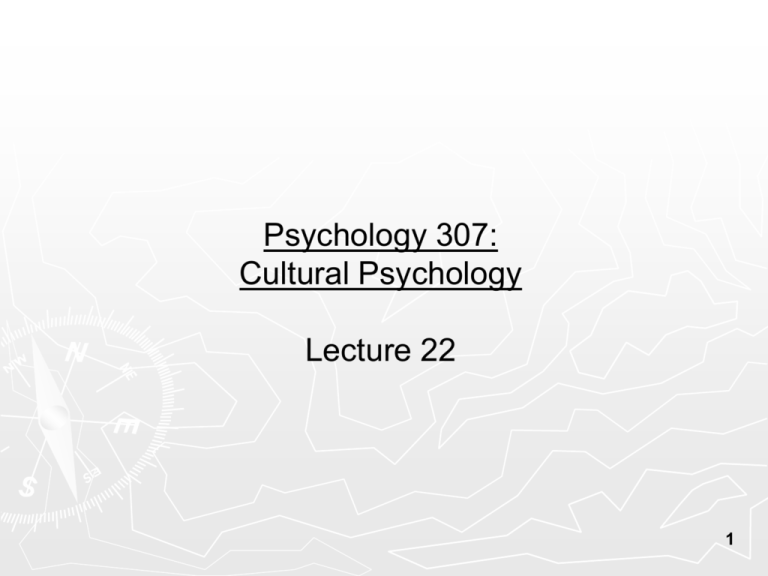
Psychology 307: Cultural Psychology Lecture 22 1 Announcement Will and Kate will extend their upcoming office hours for students who are interested in reviewing their exam: Kate (A-Q): Monday, April 11th, 12:00-2:00 Will (R-Z): Thursday, Aril 7th, 12:00-2:00. Kate’s office hour will be cancelled on Monday, April 18th. 2 Acculturation 1. What are acculturation strategies and how are they measured? (continued) 2. What are the psychological correlates of distinct acculturation strategies? 3. Do multicultural experiences foster creativity? 3 By the end of today’s class, you should be able to: 1. describe distinct acculturation strategies and their relations to psychological adjustment. 2. explain how multicultural experiences foster creativity. 4 What are acculturation strategies and how are they measured? (continued) ● Recent research has provided support for the distinction between alternation and fusion, suggesting that there are at least five acculturation strategies that people may use—assimilation, separation, alternation, fusion, and marginalization. ● Acculturative strategies are typically measured using self-report questionnaires: 5 The Vancouver Index of Acculturation (Ryder et al., 2000) 1. 2. 3. 4. 5. 6. 7. 8. 9. 10. 11. 12. 13. 14. 15. 16. I often participate in my heritage cultural traditions. I often participate in mainstream North American cultural traditions. I would be willing to marry a person from my heritage culture. I would be willing to marry a North American person. I enjoy social activities with people from the same heritage culture as myself. I enjoy social activities with typical North American people. I am comfortable working with people of the same heritage culture as myself. I am comfortable working with typical North American people. I enjoy entertainment (e.g., movies, music) from my heritage culture. I enjoy North American entertainment (e.g., movies, music). I often behave in ways that are typical of my heritage culture. I often behave in ways that are ‘typically North American.’ It is important for me to maintain or develop the practices of my heritage culture. It is important for me to maintain or develop North American cultural practices. I believe in the values of my heritage culture. I believe in mainstream North American values. 6 The Acculturation Questionnaire (Campbell et al., 2003) I do things the Canadian way. My attitudes and behaviours are consistent with Canadian norms and values. I think and act like a Canadian when I am among Canadians and when I am among Indians. I do things the Indian way. My attitudes and behaviours are consistent with Indian norms and values. I think and act like an Indian when I am among Indians and when I am among Canadians. I do some things the Canadian way and some things the Indian way. Some of my attitudes and behaviours are consistent with Canadian norms and values, and some of my attitudes and behaviours are consistent with Indian norms and values. The way I think and act when I am among Canadians and when I among Indians does not change—it combines aspects of both Canadian culture and Indian culture. 7 I adapt to which ever cultural environment I am in. When I am among Canadians, I do things the Canadian way—my attitudes and behaviours are consistent with Canadian norms and values. When I am among Indians, I do things the Indian way—my attitudes and behaviours are consistent with Indian norms and values. The way I think and act is determined by the cultural environment that I am in at a given time. I do things neither the Canadian way nor the Indian way. My attitudes and behaviours are not consistent with either Canadian norms and values or Indian norms and values. The way I think and act when I am among Canadians and when I am among Indians does not reflect aspects of either Canadian culture or Indian culture. 8 What are the psychological correlates of distinct acculturation strategies? ● To date, the bulk of research examining the psychological correlates of acculturation strategies has focused on the 4 strategies identified by the twodimensional model. ● In general, this research suggests that integration is the most adaptive acculturation strategy. 9 ● However, one study has examined the psychological correlates of the 5 acculturation strategies recently identified by theorists: Campbell et al. (2003). Recruited South Asian Canadian participants. Measured the following constructs: 1. Acculturation strategies. 2. Psychological adjustment: (a) Depression, (b) anxiety, (c) somatization, (d) self-esteem, (e) life satisfaction. 10 3. Self-concept organization: (a) Self-concept clarity (SCC): The extent to which selfbeliefs are clearly and confidently defined, internally consistent, and temporally stable. (b) Self-concept differentiation (SCD): The degree to which people see themselves as having different personality characteristics in different social roles. (c) Self-discrepancies (SDs): The degree to which people experience discrepancies between who they believe they are and who significant others believe they are. 11 Found that: (a) Alternation and fusion are used more frequently than assimilation, separation, and marginalization. (b) Alternation is associated with relatively low levels of psychological adjustment; fusion is associated with relatively high levels of psychological adjustment. 12 (c) Alternation is associated with relatively low levels of SCC and high levels of SCD and SDs; fusion is associated with relatively high levels of SCC and low levels of SCD and SDs. (d) Self-concept organization mediates the relationship between acculturation strategies and psychological adjustment. 13 Do multicultural experiences foster creativity? ● Researchers have speculated that creative insight (seeing problems in novel ways) may be fostered by acculturative experiences. ● Many famous artists and writers have had multicultural experiences. Paul Gauguin Georgia O’Keefe Emily Carr Ernest Hemingway George Handel Pablo Picasso “Once I went (abroad) it was extremely exciting for me to become a new personality, to be detached from everything that bound me, noticing everything that was different. That noticing of difference was very important.” Richard Wright ● Research suggests that multicultural experiences enhance creativity: Example: Maddux & Galinsky (2010, in press) Study 1: Participants were individuals who had lived in more than one culture and individuals who had travelled abroad as tourists. Presented participants with the Duncker candle problem: 17 How could you attach the candle to the wall so that it burns properly, and doesn’t get wax on the floor or table, using only these objects? Found that: Participants who had lived abroad were more likely to solve this problem than participants who had travelled abroad as tourists or had never been abroad. 19 Study 2: Participants were individuals who had lived in more than one culture. Exposed participants to one of two conditions: 20 “Functional multicultural learning” condition: Asked participants to recall and write about a multicultural experience in which they learned something novel and were able to figure out the reasons for it. “Non-functional multicultural learning” condition: Asked participants to recall and write about a multicultural experience in which they learned something novel and were not able to figure out the reasons for it. 21 Presented participants with the Duncker candle problem: Found that those in the functional multicultural learning condition were more likely to solve the problem than those were in the nonfunctional multicultural learning condition. Why? 22 Duncker Candle Solutions (%) Acculturation 1. What are acculturation strategies and how are they measured? (continued) 2. What are the psychological correlates of distinct acculturation strategies? 3. Do multicultural experiences foster creativity? 24

